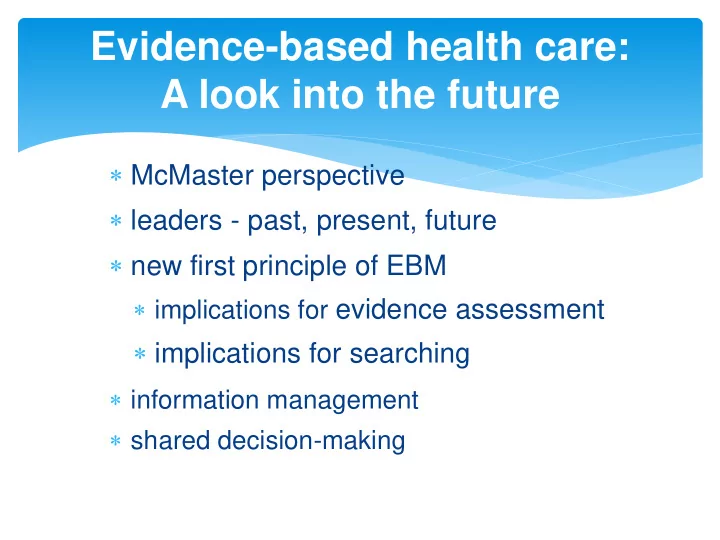

Evidence-based health care: A look into the future McMaster perspective leaders - past, present, future new first principle of EBM implications for evidence assessment implications for searching information management shared decision-making
Thrombolytic Therapy Textbook/Review 0.5 1.0 2.0 Cumulative Recommendations Year RCTs Pts Not Mentioned Experimental Rare/Never 1 23 Routine Specific 1960 2 65 1965 3 149 21 5 4 316 1970 7 1793 1 10 1 2 10 2544 P<.01 11 2651 15 3311 2 8 17 3929 22 5452 7 23 5767 8 1980 1 12 27 6125 P<.001 8 4 30 6346 M 1 1985 33 6571 M 1 3 7 43 21 059 54 22 051 P<.00001 M 5 2 2 1 65 47 185 67 47 531 M 15 8 1 1990 70 48 154 6 1 M Odds Ratio (Log Scale) Favours Treatment Favours Control
First principle systematic summaries of the best available evidence should guide patient management decisions
GRADE system to guide interpretation of systematic reviews to inform clinical guidelines and clinical decisions system for developing recommendations
70+ Organizations 2008 2010 2005 2006 2007 2009 2011 5
GRADE uptake
First principle: Hierarchy of Evidence for Therapy Randomized Trials Observational studies patient-important outcomes Basic research test tube, animal, human physiology Clinical experience
Beyond the old hierarchy: Guides to confidence in estimates
Further advances in GRADE: coming up application to systematic reviews of prognosis overall prognosis of population identification of risk factors clinical prediction rules application to systematic reviews of diagnosis confidence in estimates utility – treat as an intervention
Beta blockers in non-cardiac surgery Summary of Findings Quality Assessment Relative Absolute risk Quality Effect difference Number of (95% CI) Risk of Publication Outcome participants Consistency Directness Precision Bias Bias (studies) Myocardial 10,125 No serious No serious No serious No serious Not 0.71 1.5% fewer High infarction (9) limitations imitations limitations limitations detected (0.57 to 0.86) (0.7% fewer to 2.1% fewer) 0.5% more 10,205 No serious Possiblly No serious Not Moderate 1.23 Mortality Imprecise (0.1% fewer (0.98 – 1.55) (7) limitations inconsistent limitations detected or low to 1.3% more) 10,889 No serious No serious No serious No serious Not 2.21 0.5% more Stroke High (1.37 – 3.55) (5) limitaions limitations limitations limitations detected (0.2% more to 1.3% more0
Clinicians need pre-appraised evidence Clinicians need guidance on applying that evidence
Evidence-Based Journals Critical Appraisal Filters ~3,500 articles/y 30,000 articles/y meet appraisal and content criteria from 120 journals (93% ‘noise’ reduction)
McMaster PLUS Project ~20 articles/yr for clinicians (99.96% ~3,500 articles/y noise reduction) meet critical appraisal and ~5-50 articles/y for content criteria authors of evidence- based guidelines and reviews Health Knowledge Refinery
What is the problem? Lacking trustworthiness of guidelines - GRADE Inefficient guideline authoring, adaptation and dynamic updating Inefficient guideline dissemination to clinicians at the point of care Suboptimal presentation formats of guideline content Inconsistent and under-developed systems for integration in EMRs
STEP 1 develops: - Authoring tool template Electronic SNAP-IT GRADE GUIDELINE - Electronic outputs authoring tool DECIDE - Optimal formats - Integration in EMR Individual Descriptive Evidence - Adaptation PICO studies tables profiles Database - Decision aids structured content Recommendations Key information Rationale XML language Electronic outputs Decision aids for patients Web + App and clinicians Integrated in the EMR Adaptation National/ local or EBM Textbooks
17 11/6/2013
Third principle: evidence insufficient always tradeoffs many decisions value and preference sensitive low risk atrial fibrillation anticoagulants or no anticoagulants screening breast and colon cancer primary prevention aspirin, statins, bisphosphonates cancer toxic chemotherapy
GRADE response: Strong and Weak Recommendations variability in patient preference strong, almost all same choice (> 90%) weak, choice varies appreciably interaction with patient strong, just inform patient weak, ensure choice reflects values
Values and preferences at point of care decision aids to ensure decisions consistent with individual patient values and preferences
Combination of opportunities Interactive DA GRADE : on iPads Weak recs are ideally For the clinical • framed for SDM encounter Info tailored to • patients needs Technology Enhancing Adaptive EBM & SDM To Local conversations circumstances Semi-Automated Production Evolution of decision aids for the clinical Continous Update encounter When evidence modified
Conclusion: Look into future dissemination of GRADE GRADE principles GRADE evidence summaries searching and evidence access guidelines and pre-appraised evidence evidence improved presentation guidelines/evidence summaries on smart phones, EMR push services Shared decision making increasingly central: joint conference 2015 decision aids, including electronic from guidelines
Recommend
More recommend